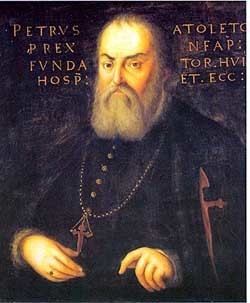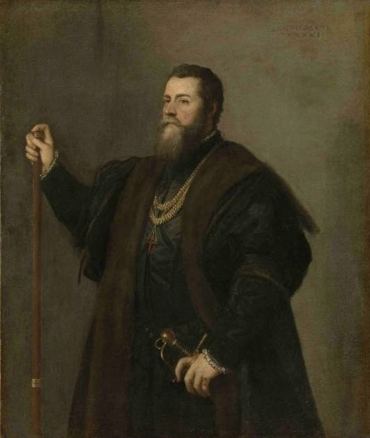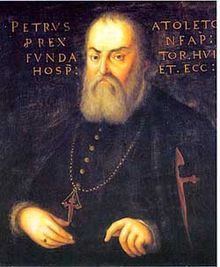Monarch Charles V Children Eleanor of Toledo Role Spanish Politician | Name Pedro de Religion Catholic | |
 | ||
Preceded by Pompeo Cardinal Colonna Succeeded by Luis Alvarez de Toledo y Osorio Born July 13, 1484
Madrid, Spain ( 1484-07-13 ) Died February 21, 1553, Florence, Italy Parents Fadrique Alvarez de Toledo, 2nd Duke of Alba Spouse Maria Pimentel (m. 1514), Juana Osorio Grandchildren Giovanni de\' Medici, Isabella de\' Medici Similar People Eleanor of Toledo, Cosimo I de\' Medici - Grand Du, Giovanni de\' Medici, Isabella de\' Medici, Pietro de\' Medici | ||
Pedro lvarez de toledo marquis of villafranca
Pedro Álvarez de Toledo y Zúñiga, jure uxoris Marquis of Villafranca del Bierzo (Spanish: Pedro Álvarez de Toledo y Zúñiga, Marqués de Villafranca del Bierzo; July 13, 1484 – February 21, 1553) was a Spanish politician. The first effective Spanish viceroy of Naples, in 1532–1552, he was responsible for considerable social, economic and urban change in the city and southern Italian kingdom, in general.
Contents
Early life

He was born in 1484 near Salamanca in Spain, the second son of Fadrique Álvarez de Toledo, 2nd Duke of Alba. His paternal grandmother was Maria Enriquez, the sister of Juana Enríquez, Queen Consort of Aragon through her marriage to widower king of Aragon Juan II of Aragon, and the mother of Ferdinand II of Aragon and ancestress of Habsburgs. Through this relation, Charles V, Holy Roman Emperor and King of Spain was a second cousin of Don Pedro.
Viceroy of Naples

Spain took over the Kingdom of Naples in 1503 and solidified her grasp after the final, failed attempt by France in 1529 to retake the kingdom. For the first three decades of the century, a succession of inconsequential viceroys ruled the vicerealm. Don Pedro arrived as viceroy in September 1532.
Don Pedro’s rebuilding of the city went on for years. Old city walls were expanded and an entirely new wall was built along the sea front. Fortresses along those walls and further up and down the coast from the city were modernized, and the Arsenale—the naval shipyards—were expanded considerably. Don Pedro also built the viceregal palace as well as a dozen blocks of barracks nearby, a square grid of streets lined with multi-storied buildings—unique in Europe for its time. Today, that section of Naples is still called the “Spanish Quarter”. The goal was to make not just the city of Naples, but the Gulf of Naples and eventually, the entire vice-realm invulnerable—that is, the entire southern Italian peninsula.
Don Pedro ruled harshly. In 1542 he closed the Accademia Pontaniana. He instituted summary execution for petty theft on public streets and made it a capital crime to go armed at night in the city. He was ruthless in dealing with feudal barons in the countryside and encouraged their moving into the city within reach of a central authority. This breaking-up of land holdings began a trend to urbanization as both the landed class and the landless peasant class poured into Naples. By 1550, the population of 200,000 was second only to Paris in all of Europe. Within the city, he centralized administration, moving all courts onto the same premises, the Castel Capuano, also known as the "Vicaria".
Don Pedro is remembered as the viceroy who tried without success to institute the Spanish Inquisition in Naples, in 1547. When the announcement of the Inquisition finally came in May 1547, the protest was immediate, turning violent very quickly. It was not a "popular" revolution, but rather a revolt by many of the landed nobility in and around Naples and Salerno, property owners who knew that the Inquisition had a reputation for confiscating the wealth and property of those whom it questioned.
Don Pedro, upon the order of the emperor Charles V, backed down and the Inquisition was called off. In 1552, Charles V calmed the populace further by sending Toledo off to Siena to handle a local problem. The viceroy died in Florence, where one of his daughters, Eleanor of Toledo was duchess consort of Medici the following year.
Don Pedro's reputation as a city-builder has stood the test of time. The city of Naples still bears his stamp in countless places. He was supposed to be entombed in the church of San Giacomo degli Spagnoli in Naples, but his sudden death in Florence meant he was buried in the Cathedral of Florence then.
Descendants
Don Pedro Álvarez de Toledo married in 1508 Maria Osorio Pimentel, 2nd Marquise of Villafranca del Bierzo. They had seven children:
Through the marriage of his youngest daughter, Eleanor of Toledo with the Grand Duke Cosimo I de' Medici in 1539, Don Pedro Álvarez de Toledo became an ancestor of Bourbon Kings of France and Spain, Habsburg-Lorraine Emperors of the Holy Roman Empire, Austria and Austria-Hungary and Grand Dukes of Tuscany, several Stuart Kings and Queens of England and Scotland, Kings of Italy from the House of Savoy, and other noble families. He is also the direct ancestor of Diana, Princess of Wales, as well as of her son, Prince William, Duke of Cambridge, the future King of Great Britain.
